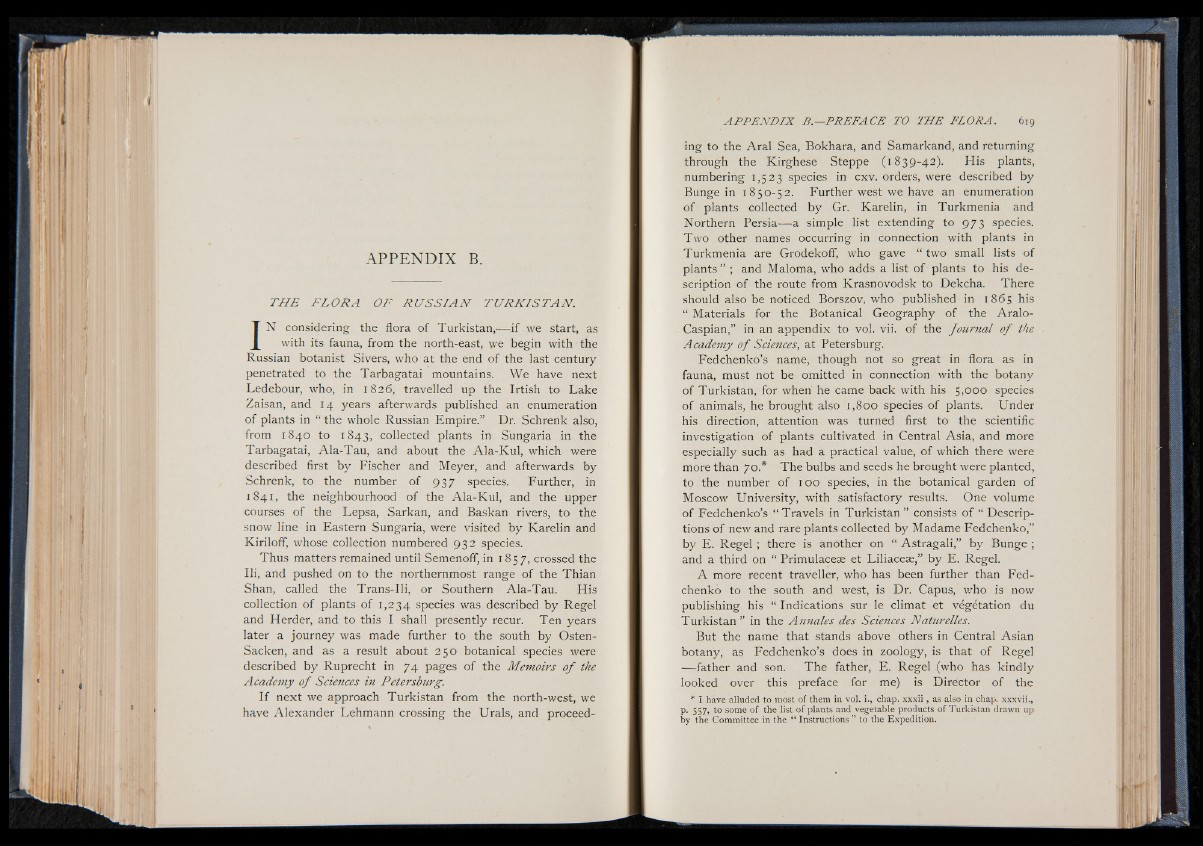
A P P E N D IX B.
TH E F LO R A O F R U S S IA N T U R K IS T A N .
IN considering the flora of Turkistan,— if we start, as
with its fauna, from the north-east, we begin with the
Russian botanist Sivers, who at the end of the last century
penetrated to the Tarbagatai mountains. We have next
Ledebour, who, in 1826, travelled up the Irtish to Lake
Zaisan, and 14 years afterwards published an enumeration
of plants in “ the whole Russian Empire.” Dr. Schrenk also,
from 1840 to 1843, collected plants in S'ungaria in the
Tarbagatai, Ala-Tau, and about the Ala-Kul, which were
described first by Fischer and Meyer, and afterwards by
Schrenk, to the number of 937 species. Further, in
1841, the neighbourhood of the Ala-Kul, and the upper
courses o f the Lepsa, Sarkan, and Baskan rivers, to the
snow line in Eastern Sungaria, were visited by Karelin and
Kiriloff, whose collection numbered 932 species.
Thus matters remained until Semenoff, in 1857, crossed the
Hi, and pushed on to the northernmost range of the Thian
Shan, called the Trans-Ili, or Southern Ala-Tau. His
collection of plants of 1,234 species was described by Regel
and Herder, and to this I shall presently recur. Ten years
later a journey was made further to the south by Osten-
Sacken, and as a result about 250 botanical species were
described by Ruprecht in 74 pages of the Memoirs o f the
Academy o f Sciences in Petersburg.
I f next we approach Turkistan from the north-west, we
have Alexander Lehmann crossing the Urals, and proceeding
to the Aral Sea, Bokhara, and Samarkand, and returning
through the Kirghese Steppe (1839-42). His plants,
numbering 1,523 species in cxv. orders, were described by
Bunge in 1850-52. Further west we have an enumeration
of plants collected by Gr. Karelin, in Turkmenia and
Northern Persia-— a simple list extending to 973 species.
Two other names occurring in connection with plants in
Turkmenia are Grodekoff, who gave “ two small lists of
plants ” ; and Maloma, who adds a list of plants to his description
of the route from Krasnovodsk to Dekcha. There
should also be noticed Borszov, who published in 1865 his
“ Materials for the Botanical Geography of the Aralo-
Caspian,” in an appendix to vol. vii. of the fournal o f the
Academy o f Sciences, at Petersburg.
Fedchenko’s name, though not so great in flora as in
fauna, must not be omitted in connection with the botany
of Turkistan, for when he came back with his 5,000 species
of animals, he brought also 1,800 species of plants. Under
his direction, attention was turned first to the scientific
investigation of plants cultivated in Central Asia, and more
especially such as had a practical value, of which there were
more than 70.* The bulbs and seeds he brought were planted,
to the number of 100 species, in the botanical garden of
Moscow University, with satisfactory results. One volume
of Fedchenko’s “ Travels in Turkistan ” consists of “ Descriptions
of new and rare plants collected by Madame Fedchenko,”
by E. Regel ; there is another on “ Astragali,” by Bunge ;
and a third on “ Primuláceas et Liliáceas,” by E. Regel.
A more recent traveller, who has been further than Fedchenko
to the south and west, is Dr. Capus, who is now
publishing his “ Indications sur le climat et végétation du
Turkistan ” in the Armales des Sciences Naturelles.
But the name that stands above others in Central Asian
botany, as Fedchenko’s does in zoology, is that of Regel
-—father and son. The father, E. Regel (who has kindly
looked over this preface for me) is Director of the
* I h a v e a l l u d e d t o m o s t o f t h e m i n v o l . i . , c h a p . x x x i i , a s a l s o i n c h a p . x x x v i i . ,
p . 5 5 7 , t o s o m e o f t h e l i s t o f p l a n t s a n d v e g e t a b l e p r o d u c t s o f T u r k i s t a n d r a w n u p
b y t h e C o m m i t t e e i n t h e “ I n s t r u c t i o n s ” t o t h e E x p e d i t i o n .